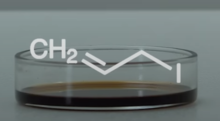Chemistry:Allyl iodide
From HandWiki

| |
| Names | |
|---|---|
| Preferred IUPAC name
3-Iodoprop-1-ene | |
| Other names
Allyl iodide
3-Iodopropene 3-Iodopropylene 3-Iodo-1-propene Iodoallylene 2-Propenyl iodide | |
| Identifiers | |
3D model (JSmol)
|
|
| ChemSpider | |
| EC Number |
|
PubChem CID
|
|
| UNII | |
| UN number | 1723 |
| |
| |
| Properties | |
| C3H5I | |
| Molar mass | 167.977 g·mol−1 |
| Appearance | Pale yellow liquid |
| Density | 1.837 g/cm3 |
| Melting point | −99 °C (−146 °F; 174 K) |
| Boiling point | 101 to 103 °C (214 to 217 °F; 374 to 376 K) |
| Hazards | |
| Safety data sheet | MSDS at Sigma Aldrich |
| GHS pictograms |  
|
| GHS Signal word | Danger |
| H225, H314 | |
| P210, P233, P240, P241, P242, P243, P260, P264, P280, P301+330+331, P303+361+353, P304+340, P305+351+338, P310, P321, P363, P370+378, P403+235, P405, P501 | |
| Flash point | 18 °C (64 °F; 291 K) |
Except where otherwise noted, data are given for materials in their standard state (at 25 °C [77 °F], 100 kPa). | |
| Infobox references | |
Allyl iodide (3-iodopropene) is an organic halide used in synthesis of other organic compounds such as N-alkyl-2-pyrrolidones,[1][failed verification] sorbic acid esters,[1] 5,5-disubstituted barbituric acids,[2][failed verification] and organometallic catalysts.[3][failed verification] Allyl iodide can be synthesized from allyl alcohol and methyl iodide on triphenyl phosphite,[4] Finkelstein reaction on allyl halides,[5] or by the action of elemental phosphorus and iodine on glycerol.[6][7] Allyl iodide dissolved in hexane can be stored for up to three months in a dark freezer at −5 °C (23 °F) before decomposition into free iodine becomes apparent.[8]
See also
References
- ↑ 1.0 1.1 Bertleff, Werner (2000). Ullmann's Encyclopedia of Industrial Chemistry. pp. 9,14–15. doi:10.1002/14356007.a05_217. ISBN 978-3527306732. "When unsaturated amines are carbonylated in the presence of Co2(CO)8, N-alkyl pyrrolidinones are obtained. Carbonylation of allyl halides in the presence of primary amines and a rhodium compound affords the same products....If allyl derivatives are carbonylated in the presence of acetylene by means of Ni(CO)4 and water or methanol at 20 °C, the acetylene adds onto the allyl halide and 2-cis-5-dienoic acids or esters or sorbic acid esters are obtained.".
- ↑ Wollweber, Hartmund (2000). Ullmann's Encyclopedia of Industrial Chemistry. p. 521. doi:10.1002/14356007.a13_533. ISBN 978-3527306732. "Disubstitution of barbituric acids at the 5-position is only possible with highly reactive halides, such as allyl halides.".
- ↑ Behr, Arno (2000). Ullmann's Encyclopedia of Industrial Chemistry. p. 10. doi:10.1002/14356007.a18_215. ISBN 978-3527306732. "Halogen-containing allyl complexes can often be prepared simply from reactions of allyl halides with metal compounds.".
- ↑ Patnaik, Pradyot (2007). A Comprehensive Guide to the Hazardous Properties of Chemical Substances 3rd Ed. New Jersey: John Wiley & Sons. pp. 141–142. ISBN 9780471714583. https://books.google.com/books?id=-CRRJBVv5d0C&q=allyl+iodide&pg=PA141.
- ↑ Adams, Rodger (1944). Organic Reactions, Volume II. New York: John Wiley & Sons, Inc.. pp. 22. https://www.scribd.com/doc/101455067/Organic-Reactions-v2.
- ↑ Schorlemmer, C. (1874). A manual of the chemistry of the carbon compounds. London: Macmillan and Co.. p. 262. https://books.google.com/books?id=VHEDAAAAQAAJ&q=262&pg=PR3.
- ↑ Datta, Rasek Lal (March 1914). "The Preparation of Allyl Iodide". Journal of the American Chemical Society 36 (5): 1005–1007. doi:10.1021/ja02182a023. https://books.google.com/books?id=BrI7AQAAMAAJ&pg=PA1005. Retrieved 15 December 2013.
- ↑ Armarego, Wilfred; Chai. Christina (2012). Purification of Laboratory Chemicals. Kidlington: Elsevier. p. 114. ISBN 9780123821614. https://books.google.com/books?id=4ViVUQi7Z60C.
 |

